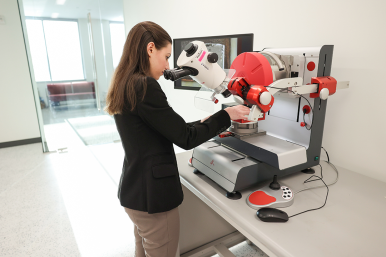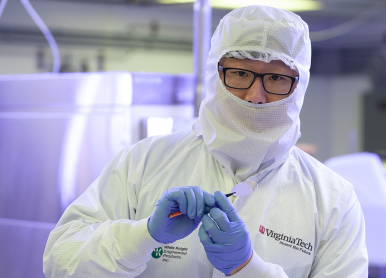
Sheena Deivasigamani is completing her master’s degree in engineering at Virginia Tech. She’s one of 19 students who earned a bachelor’s degree in engineering as a chip-scale integration major in 2023. Photo courtesy Virginia Tech

Sheena Deivasigamani is completing her master’s degree in engineering at Virginia Tech. She’s one of 19 students who earned a bachelor’s degree in engineering as a chip-scale integration major in 2023. Photo courtesy Virginia Tech
Chips ahoy
Virginia Tech sees uptick in semiconductor interest
Beth Kanter //April 29, 2024//
Finally, the world is catching up with Virginia Tech‘s semiconductor curriculum.
Virginia Tech’s College of Engineering started a chip-scale integration major in 2016, but it wasn’t exactly high profile when Sheena Deivasigamani arrived at Virginia Tech as a first-year engineering student in 2019. Chip-scale integration wasn’t even on Deivasigamani’s radar.
Tech was then an academic year away from graduating its first two students majoring in the discipline, which focuses on improving efficiency of semiconductors while lowering power consumption and adding functionality.
“I was looking for good programs in engineering, especially in computer science,” Deivasigamani says. “All I knew [at that point] about engineering was that I was good at computer science and that I wanted to go into something where I could use those skills.”
In her sophomore year, Deivasigamani took her first fundamentals of digital systems class — leading her to chip-scale integration. “It just clicked. It was intuitive to me. Everything made sense — it’s the hardware you base the software [on], and it gave me some background for the high-level [work] that we were doing.”
Fast-forward five years, and Deivasigamani has earned a bachelor’s degree in engineering from Virginia Tech as a chip-scale integration major — one of 19 students in the class of 2023 — and is completing her master’s in engineering. In June, she expects to start working at Micron Technology as an automotive product quality engineer.
Deivasigamani’s experience comes as Virginia Tech positions itself as a key player in the effort to increase domestic manufacturing of advanced semiconductors, or chips as they’re commonly called, after years of work in that direction.
Domestic demand
In 2019, chips — shorthand for semi- conductors, which process, store and receive information and are needed in everything from automobiles to medical devices to smartphones — were known among engineers but not the general public.
Although transistors and semiconductor chips were invented in the United States, Taiwan became the world’s top producer of semiconductors, manufacturing 22% of all chips and more than 90% of the most technologically advanced chips that are most in demand for U.S. military gear and tech devices. As of April 2024, the U.S. produced only about 10% of all semiconductors, although the nation continues to be a leader in designing chips.

In 2020, increased demand for chips led to a global shortage, slowing car manufacturing and raising vehicle prices, as well as sparking worries that a second pandemic could collapse the global supply chain. Members of Congress began to take action, writing legislation that would allocate funding to grow domestic production of chips, while bolstering competition with China, the globe’s third largest semi-
conductor manufacturer after South Korea.
In August 2022, President Joe Biden signed the CHIPS and Science Act, a federal statute authorizing about $280 billion in new funding for domestic research and manufacturing of semiconductors, including $39 billion in federal grants going to companies — including the Taiwan Semiconductor Manufacturing Co. and Intel — to set up new factories in the U.S.
All of the activity in Washington, D.C., delivered more attention to semiconductors and the need for more trained engineers like Deivasigamani and her classmates working in the U.S. Over the past few decades, Taiwan, South Korea and China became leaders in chip manufacturing by luring tech companies with incentives. Meanwhile, the U.S.’s share of chip production slid from 37% in 1990 to about 12% in 2022.
“Semiconductors enable the key technologies driving the future economy and our national security — AI, 5G/6G, quantum computing, cloud services, etc.,” according to a 2022 report from the Semiconductor Industry Association. “The current shortage of chips highlights the vital role of semiconductors throughout the entire economy — including aerospace, automobiles, communications, defense systems, information technology, manufacturing, medical technology and others.”
The prodigious growth of AI-powered tools like ChatGPT also has increased chip demand. In February, Silicon Valley chipmaker Nvidia’s CEO, Jensen Huang, predicted the start of a “10-year cycle” of semiconductor growth fueled by AI — and Goldman Sachs’ trading desk declared Nvidia’s rising stock “the most important stock on Planet Earth.” The company’s annual revenues jumped 265% year-over-year, to $22.1 billion.
While numbers like that tend to get people excited about entering the semiconductor industry, there are still some challenges for the U.S. to fully benefit.
“We have a steep hill to climb in order to get back that 37% market share,” says Luke Lester, department head for Virginia Tech College of Engineering‘s Bradley Department of Electrical and Computer Engineering and co-creator of the college’s chip-scale integration major. “We are not going to be able to meet that demand for new chips and manufacturing them in the United States and North America unless we make the investment in the people. Workforce development is a big deal.”
“More complicated software needs better and better hardware to run,” Deivasigamani says. “You can’t keep forcing new technologies on older systems.”
Lester compares this moment in the domestic semiconductor landscape to the Northeast blackout of 2003, which impacted much of the Northeastern and Midwestern U.S. and parts of Canada, highlighting the power grid’s vulnerabilities.
“The marketplace cycles,” Lester explains. “Twenty-five years ago, power systems — the grid — was considered a solved problem. All of the sudden, people realized it’s not just, ‘I flip my switch and the power goes on.’ Because an oak tree fell somewhere in Ohio, it disrupted the whole grid, and that got studied. We are in a similar situation with the CHIPS Act and the investment being made in [semiconductor] manufacturing.”
The CHIPS and Science Act was a tipping point for increased interest in the chip-scale integration program at Virginia Tech, saving the major from potential oblivion.
“The first four years [of the major], I wondered, ‘Are we going to need to sunset this?’” due to lack of interest, Lester recalls. “Now I have students say to me … ‘I am going to major in chip-scale integration,’ and four or five years ago I didn’t hear that at all. I used to hear robotics.”

What’s next
In May 2016, chip-scale integration was just one of 14 new majors in electrical engineering and computer engineering, supported by a $2 million National Science Foundation grant awarded to Virginia Tech in July 2016.
Now, there’s far more interest. So far, 88 students have enrolled in Virginia Tech’s chip-scale integration major, with significant increases since the CHIPS Act became law, and 33 students have graduated with chip-scale integration as part of their degree.
Also, Virginia Tech is one of 21 founding members of the Northeast University Semiconductor Network formed by Micron, which was announced in 2023, and the university is the anchor institution for the Virginia Alliance for Semiconductor Technology (VAST), a coalition of universities, government entities and industry partners. VAST began in 2023 when GO Virginia awarded the group $3.3 million to fund its creation.
“We need to establish a cloud-based management systems that connects all of these facilities together,” says Virginia Tech researcher Masoud Agah, VAST’s founding executive director. “Imagine if you have a single point of entry, then you can have access to all of the facilities across the commonwealth.”
Next up for Tech is semiconductor packaging, another essential piece of the domestic production puzzle and an important part of Virginia Tech’s semiconductor workforce development efforts.
Only about 3% of semiconductor packaging is fabricated domestically, a figure the federal government hopes to improve.
“There is a big effort in the CHIPS Act related to packaging, and recognizing that it is also a major kind of supply chain bottleneck when it comes to chips in the U.S.,” says Christina DiMarino, an assistant professor based at Virginia Tech’s Center for Power Electronics Systems in Arlington County. “Many of my students are working on packing these power semiconductor devices, and they’re really looking at kind of the next generation of these power semiconductor devices that are more advanced.”
Key to developing modern semiconductor packaging is time in a fabrication lab — also known as the “fab” — where students work with chips and their fragile components in a controlled, dust-free environment.
“There are mechanical considerations, material science consideration, reliability, physics, chemistry, etc.,” DiMarino says. “It’s really a great example of a multidisciplinary research topic. Packaging has largely been developed in industry, and there are very few courses on it, especially in the United States.”
With relevant skills in hand, DiMarino’s students have gone on to secure positions after graduation with Rockwell Automation, BAE Systems, Wolfspeed, and the National Institute of Standards and Technology.
“There’s very high demand for people working on packaging right now,” she says. “I cannot graduate enough students, apparently.”
Another area of increasing demand is manufacturing power switches that are more efficient and less harmful to the environment, and DiMarino and CPES researcher Yuhao Zhang are working with students on that as well.
“Semiconductors are expected to have a market size that will grow very fast, reaching over $10 billion by 2027,” says Zhang, whose work has the potential to provide energy savings in many arenas like data centers, electric vehicles, mobile electronics and the electric grid. “They [also] are the key for carbon neutrality of the entire society.”
Virginia Tech at a glance

Campus
Virginia Tech’s main campus in Blacksburg stretches over 2,600 acres. Tech also has regional presences statewide and a study-abroad campus in Switzerland, and the university’s Innovation Campus for computer science and computer engineering graduate students will open in Alexandria in 2025.
Enrollment (Fall 2023)
- Undergraduate: 30,504
- Graduate and professional: 7,790
- In-state: 23,587
- International: 4,011
Student profile
- Male: 57%
- Female: 43%
- Students of color: 12,150
Employees
- Full-time employees: 8,750
- Research and teaching faculty: 2,843
Tuition, fees, housing and financial aid*
- In-state undergraduate: $15,476
- Out-of-state undergraduate: $36,693
- Room and board: $11,746
- Average financial aid awarded to full-time, in-state undergraduates seeking assistance in 2021-22: $8,588
*2023-24 figures, except as noted
>

















